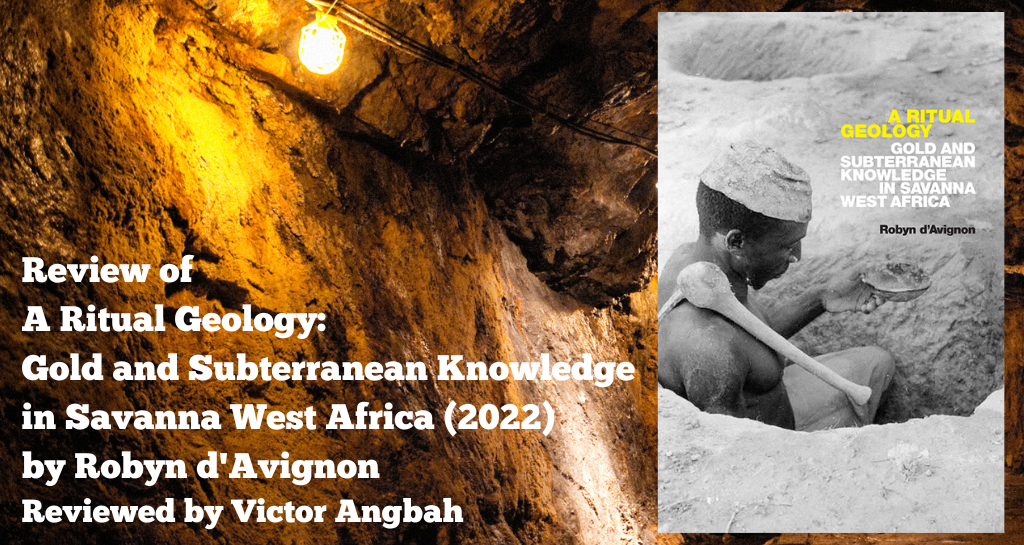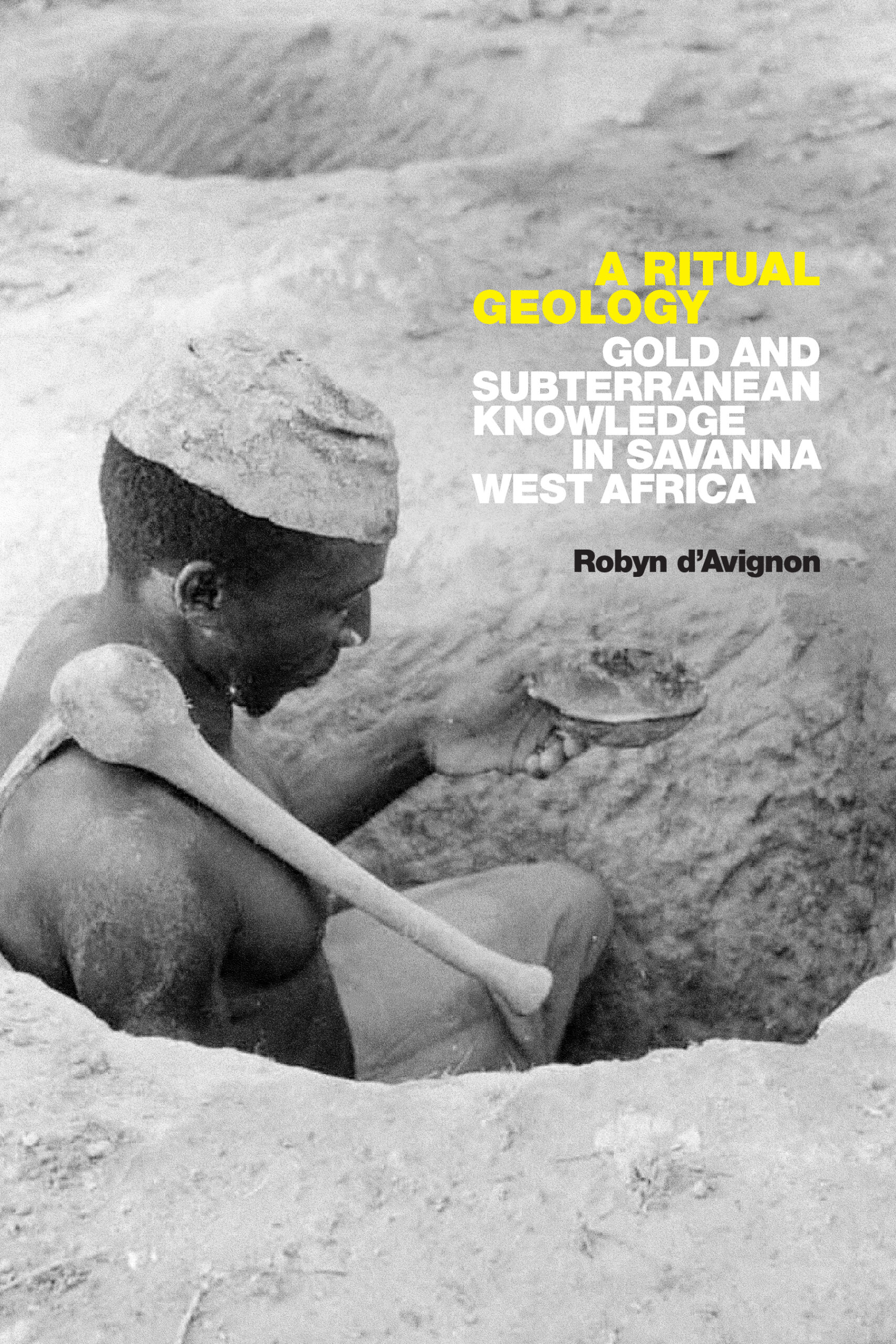
Using the goldfields in Kedougou in southeastern Senegal, historian and anthropologist Robyn D’Avignon, in Ritual Geology, explores the instrumentality of African indigenous knowledge systems in developing modern mining economies in French West Africa from the nineteenth century to the present. D’Avignon defines ritual geology as a set of practices, prohibitions, and cosmological engagements with the earth widely shared and cultivated across a regional geological formation in French West Africa. Her work affirms African agency in West Africa’s literature on the environment and challenges French colonial narratives about West Africa. For those familiar with the literature on mining in Anglophone West Africa, her work bridges an intellectual gap by providing the Francophone perspective on the development of mining in West Africa. Also, Ritual Geology significantly contributes to West Africa and Africa’s growing body of environmental history. It points to new avenues of research on vital themes in West African history, such as indigenous knowledge systems, religious syncretism, the historical relationship between artisanal and industrial mining, material culture, migration, and international relations, all within environmental history. D’Avignon’s work provides a conducive entry into the ecological history of French West Africa.

In Ritual Geology, D’Avignon sought to provide a narrative that gives agency to African mining culture in a relatively unbalanced field historiographically. Colonial narratives of geological exploration relegated African indigenous knowledge systems in mining economies to the base of the imperial pyramid while extolling Western knowledge systems as effective and environmentally friendly, which became a significant justification for colonization. Traditional mining was described as customary or artisanal and, thus, limited to a locale, whereas Western mining was industrial and global. This perception, d’Avignon argues, has gained popularity in the environmental histories of Africa, leading scholars to overlook the central role of African expertise in geological exploration in colonial and postcolonial periods. D’Avignon challenges common historiography by proposing to examine the region’s Ritual Geology. Regarding the role of Africans in modern geology in West Africa, d’Avignon identifies two threads: Africans as intellectual actors in the emergence of contemporary exploration geology and, second, Africans’ claim to mineral resources and trade as their natural rights.
Divided into seven chapters, d’Avignon begins by mapping Kedougou (the study area) and identifying the book’s main characters. The characters are presented as personalities (communities), corporate firms, and the political state (colonial and postcolonial). She argues that the various characters blur the line between legal and illegal artisanal and industrial extractions. However, she skillfully weaves different anthropological narratives of characters that paint a vivid picture of artisanal mining in Senegal. The study period witnessed women’s changing role in artisanal mining at Kedougou as the scale of dominance tilted to men from the colonial period to the present. Before colonial rule, women were key at both the exploitative and refinery stages of artisanal mining. However, excessive competition for geological resources during the colonial period led to the relegation of women to the base of production in artisanal mining. Another pattern of change was the emergence of Islam in the study area and how, over time, indigenous miners have been able to merge traditional religion and Islam in mining activities.

D’Avignon explores the development of West African ritual geology from the eighth to the twentieth century. Drawing on oral tradition, she recounts how, within the context of survival strategies, gold-producing communities occupied Birimian rocks over the past millennium and identifies three elements in West Africa’s ritual geology. First, the existing literature is silent on gold-producing communities and their relationship to mineralized land. She attributes this to scarcity of sources and argues that non-centralized societies controlled gold mining during this period. Second, the emergence of Islam in West Africa began the denigrating and racializing of African miners as pagans. Lastly, the West African communities of the Savanna and Sahel regarded gold as a dangerous occult substance tied to spirits, including malevolent ones. The latter position is very prevalent in the sub-region, and there is a need for further research into other Anglophone regions in West Africa. Another area that needs further research is the recent incursion of Chinese miners into West Africa. Questions like what led to the incursion and whether these developments have impacted artisanal mining need to be interrogated.
In examining the role of African expertise and technological knowledge in colonial mining economies, d’Avignon contests colonial narratives of mining and shows how it displaced indigenous mining economics in French West African colonies of Soudan, Senegal, and Burkina Faso. Colonial mining records presented Indigenous mining as inferior in expertise and technology and gave Indigenous miners as degrading the land and engaging in fetish activities. The latter was considered among the Abrahamic religions as barbaric and unconventional. D’Avignon maintains that French colonial narratives defined African mining customs based on a vertical and horizontal rights division. The former presents African technological machinery as inferior, and the latter explains how African mining rights are geographically limited. Irrespective of the negative tag, orpaillage customary rights triumphed over time, allowing indigenous peoples to earn personal wealth. Furthermore, D’Avignon discusses the ambivalent nature of traditional rights in French West Africa; those rights prohibited Africans from mining gold, but they were seasonal and usufruct rights that territorial administrators could rescind. Also, Africans were barred from accessing more stable mineral property rights because they were consigned with customary rights.

D’Avignon explores subterranean rights in gold mining among the Kedougou people (Southeastern Senegal) in the mid-2000s. She does this within the context of legitimizing indigenous mining and focuses on the discursive elements of claim-making. According to D’Avignon, there were four primary modes of Africans asserting their claim to gold mines. First, the claim to discover or produce. Second, orpailleurs (local miners) claim juura (mining sites) as a subsistence right. Thirdly, orpaillage claims to mine only surface mining. Finally, orpaillage have the right to gold mines because they have been marginalized from colonial to postcolonial periods. D’Avignon, therefore, documents the language of subterranean rights innovated by Africans.
Focusing on mining during the colonial period, d’Avignon explores French articulation in West Africa and how French geologists relied on it for their mining activities in the region. The period witnessed how the French capitalized on indigenous mining systems in mapping the geology of West Africa. However, it is essential to note that little has been revealed about the role and identity of West Africans who participated in the geological exploration. Here, d’Avignon’s work inserts African agency in developing geology in West Africa by examining the role of some key personalities from different regions. D’Avignon avers that West Africa’s ritual geology witnessed rapid evolution during the colonial period as orpailleurs adopted new techniques from European geologists and moved to new Birimian fields for mining.

Source: Wikimedia Commons.
The politics in the aftermath of World War II played a crucial role in the development of mining in West Africa. D’Avignon brings West African mining activities into the narratives of the Cold War. She extends our knowledge of the Cold War politics of mineral resources in the Congo basin to the Birimian regions of West Africa. The Cold War period witnessed an influx of mining companies into West Africa as newly independent states began to leverage competing offers for technical assistance to meet their national goals. The period thus saw interactions between African states and the main actors of the Cold War. For example, Senegal engaged Euro-American and Soviet geologists in mining initiatives. An essential highlight during this period was the criminalization of orpaillage in some independent West African states such as Senegal. Influenced by the politics of the Cold War, African leaders saw orpaillage as antithetical to the principles of African socialism and a hindrance to newly African governments’ efforts to build modern nationalized industries. However, a series of droughts in the 1970s made most West African leaders to reconsider the criminalization of orpaillage adopted at independence.
Ritual Geology is an excellent addition to the study of the relationship between African knowledge systems within the context of indigenous mining culture and Western (colonial) science in West Africa. The latter operates under the pretext of regulating the environment of settler communities. In this vein, settler communities function as “laboratories” where colonial theories are experimented. This is evident in the works of scholars such as Richard Grove, Peder Anker, Helen Tilley, and Megan Black, who illustrate how the colonial powers of the West established research stations in Africa as centers for ecological research. D’Avignon’s work, therefore, demonstrates the resilient nature of African knowledge systems of mining in French West Africa in the face of Western science incursion from the colonial period to the present. Again, D’Avignon shows how the collaboration between African mining culture and Western science has contributed to modern mining in French West Africa, a position that gives primacy to the instrumentality of ethnoscience in Africa.
Victor Angbah is a doctoral student in the Department of History at the University of Texas at Austin. His research interests include education, agriculture, and riverine histories of Africa. He is currently researching the symbiotic relationship between the Pra River and the Akan people of Ghana, West Africa, in the 19th and 20th centuries.
The views and opinions expressed in this article or video are those of the individual author(s) or presenter(s) and do not necessarily reflect the policy or views of the editors at Not Even Past, the UT Department of History, the University of Texas at Austin, or the UT System Board of Regents. Not Even Past is an online public history magazine rather than a peer-reviewed academic journal. While we make efforts to ensure that factual information in articles was obtained from reliable sources, Not Even Past is not responsible for any errors or omissions.